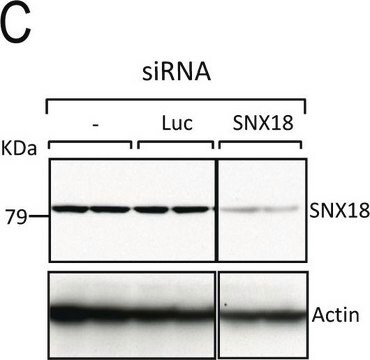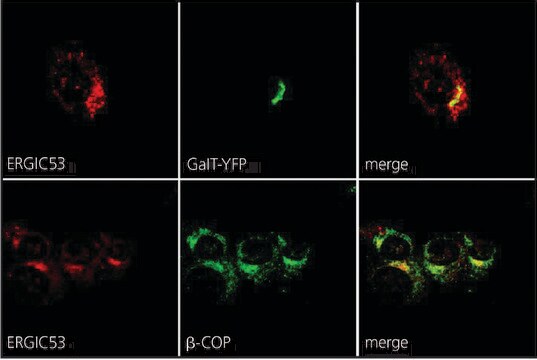Key Documents
G2279
Monoclonal Anti-β-COP antibody produced in mouse
clone M3A5, ascites fluid
Synonim(y):
Anti-BARMACS, Anti-COPB
About This Item
Polecane produkty
pochodzenie biologiczne
mouse
Poziom jakości
białko sprzężone
unconjugated
forma przeciwciała
ascites fluid
rodzaj przeciwciała
primary antibodies
klon
M3A5, monoclonal
zawiera
15 mM sodium azide
reaktywność gatunkowa
monkey, human, chicken, goose, rabbit, canine, bovine, kangaroo rat, rat, hamster
metody
immunocytochemistry: suitable
immunoprecipitation (IP): suitable
indirect immunofluorescence: 1:20 using cultured Chinese hamster ovary (CHO) cells
izotyp
IgG1
numer dostępu UniProt
Warunki transportu
dry ice
temp. przechowywania
−20°C
docelowa modyfikacja potranslacyjna
unmodified
informacje o genach
human ... COPB1(1315)
rat ... Copb1(114023)
Opis ogólny
Specyficzność
Immunogen
Zastosowanie
- for the localization of β-COP using immunoprecipitation
- in immunocytochemistry
- in immunoblotting
- with other antibodies to Golgi proteins to study the role and relationships of this protein in the cell
Działania biochem./fizjol.
Oświadczenie o zrzeczeniu się odpowiedzialności
Nie możesz znaleźć właściwego produktu?
Wypróbuj nasz Narzędzie selektora produktów.
Kod klasy składowania
10 - Combustible liquids
Klasa zagrożenia wodnego (WGK)
nwg
Temperatura zapłonu (°F)
Not applicable
Temperatura zapłonu (°C)
Not applicable
Certyfikaty analizy (CoA)
Poszukaj Certyfikaty analizy (CoA), wpisując numer partii/serii produktów. Numery serii i partii można znaleźć na etykiecie produktu po słowach „seria” lub „partia”.
Masz już ten produkt?
Dokumenty związane z niedawno zakupionymi produktami zostały zamieszczone w Bibliotece dokumentów.
Nasz zespół naukowców ma doświadczenie we wszystkich obszarach badań, w tym w naukach przyrodniczych, materiałoznawstwie, syntezie chemicznej, chromatografii, analityce i wielu innych dziedzinach.
Skontaktuj się z zespołem ds. pomocy technicznej








